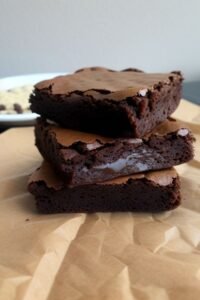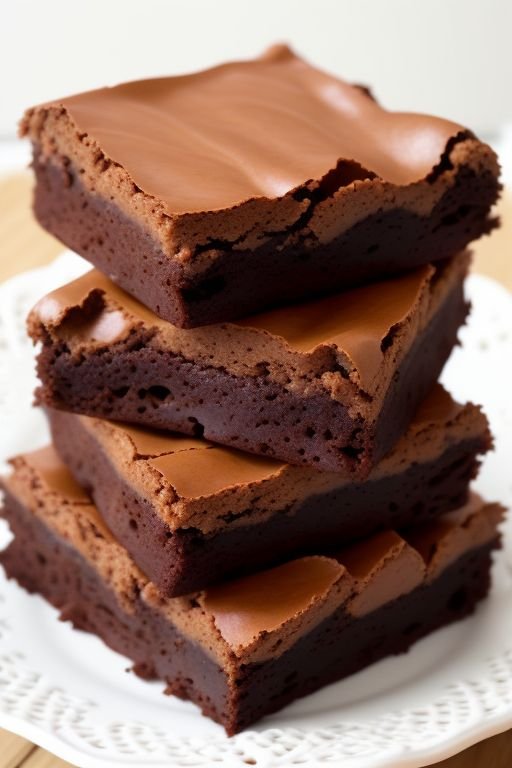What are the three types of brownies? In this detailed exploration, we dive into the delightful world of brownies, uncovering the secrets behind the three main types of brownies: fudgy, chewy, and cakey. Each variety offers a unique taste and texture, appealing to different palates and preferences. Beyond the basics, we’ll explore innovative variations, offer practical baking tips, and answer some frequently asked questions. Whether you’re a novice baker or a seasoned pro, this guide aims to enhance your brownie-baking skills and inspire your culinary creativity.
What are the three types of brownies?
What are the three types of brownies? Brownies, a staple in American desserts, have charmed their way into the hearts of people worldwide. Originating in the late 19th century, the first recorded recipe appeared in the 1896 edition of the Boston Cooking-School Cook Book. Characterized by its dense, rich texture, this beloved treat has evolved through decades, adapting to various tastes and styles.
Overview of Brownie Types
When it comes to brownies, texture is everything. Fudgy brownies are rich and moist, packed with butter and chocolate for density. Cakey brownies resemble light cakes, thanks to more flour and baking powder for fluffiness. Chewy brownies combine moisture with a firmer bite, often using an extra egg or brown sugar. Each type satisfies different dessert cravings, allowing for numerous personalized creations.
Detailed Analysis of Brownie Types
Fudgy Brownies
What are the three types of brownies? Fudgy brownies are the quintessence of chocolatey decadence. The secret to their rich, dense texture lies in a generous use of fats like butter and chocolate, combined with minimal flour. These brownies often skip the leavening agents like baking powder, relying instead on eggs to bind the ingredients without adding much air. Chocolate lovers frequently prefer fudgy brownies for their intense, deep chocolate flavor. For the best results, use high-quality chocolate and cook just until they’re set; a slightly underbaked middle is the hallmark of the perfect fudgy brownie.
Chewy Brownies
The allure of chewy brownies lies in their delightful texture, achieved through the addition of more flour and an extra egg. This type ensures the brownies have more body than their fudgy counterparts, with a moist, dense texture that still has a bit of chew. Brown sugar is a critical ingredient here, as its molasses content contributes to the chewiness. For those who like a bit more texture in their bite, chewy brownies are a match made in heaven. They strike a delicate balance, appealing to those who find the fudgy variety too dense and the cakey type too dry.
Cakey Brownies
Cakey brownies stand out with their light, airy texture, akin to a classic sponge cake. Achieving this fluffiness involves using a bit more flour and a leavening agent like baking powder to help them rise. The proportion of fats is reduced compared to fudgy brownies, and the batter is usually beaten well to incorporate air, making them softer and lighter. Cakey brownies are perfect for those who love the flavor of brownies but prefer a less intense, more delicate dessert experience. They often serve as a base for various toppings and mix-ins, providing a versatile foundation for creative dessert concoctions.
In this segment of our brownie exploration, we’ve whisked through the textures and tastes of three beloved types. Each brings its own unique charm to the table, catering to different dessert desires and baking styles. Whether you lean towards the dense and moist, the balanced and chewy, or the light and airy, there’s a brownie type to satisfy every craving.
Brownie Variations and Innovations
Special Ingredients and Flavors
What are the three types of brownies? Exploring the world of brownies extends far beyond the classic chocolate. Today’s innovative bakers infuse an array of special ingredients to elevate the humble brownie. From swirls of creamy cheesecake to dollops of peanut butter, each addition offers a unique twist that transforms the traditional flavor profile. Seasonal ingredients like peppermint during the holidays or pumpkin spice in the fall provide timely variations that cater to festive palates. For those seeking a gourmet experience, incorporating ingredients such as espresso or sea salt can enhance the depth and complexity of the chocolate flavor, making each bite a luxurious indulgence.
Nutritional Variations (Gluten-Free, Vegan)
As dietary needs change, so do brownie recipes, accommodating various health and lifestyle preferences. Gluten-free brownies use alternative flours like almond or coconut, offering a tasty solution for those avoiding gluten without losing texture or taste. Vegan brownies substitute eggs and butter with flax eggs, applesauce, or vegan butter alternatives, allowing everyone to enjoy them despite dietary restrictions. These changes not only make brownies more accessible but also bring new textures and flavors, enriching the baking landscape.
Brownie enthusiasts continue to enjoy a vast range of flavors and styles by embracing traditional and innovative ingredients. Adding a dash of cinnamon for warmth or experimenting with plant-based ingredients for vegan treats opens endless possibilities. This culinary creativity ensures brownies remain a beloved dessert for everyone, regardless of dietary preferences or flavor inclinations.
Baking Tips and Techniques
Achieving Desired Brownie Textures
Perfecting brownie textures requires a blend of precise ingredients and meticulous baking techniques. To achieve the fudgy texture, focus on a high fat-to-flour ratio and minimize mixing to keep air out. For chewy brownies, the addition of an extra egg and a higher proportion of brown sugar will help create the desired consistency. If you’re aiming for cakey brownies, incorporate more flour and use a whisk or mixer to beat air into the batter, promoting a lighter texture.
Common Baking Mistakes
Avoiding common baking mistakes can greatly enhance the quality of your brownies. Overbaking is a frequent error, leading to dry, crumbly results instead of moist, rich textures. Use a timer and check your brownies frequently as they approach the recommended baking time. Another mistake is improper measuring of ingredients, particularly flour. Too much flour can make brownies cakey when you want them fudgy. Be sure to use the spoon-and-level method or a kitchen scale for precision. Lastly, mixing the batter too vigorously can incorporate too much air, affecting the dense, compact structure characteristic of brownies. Stir just until the ingredients are combined for the best outcome.
By adhering to these tips and being mindful of common pitfalls, you can significantly improve your brownie baking skills. Whether you’re a novice or an experienced baker, mastering these techniques will allow you to consistently produce delicious brownies that are sure to impress at any gathering or satisfy any sweet craving.
Pairing and Serving Suggestions
The Art of Pairing Brownies
Choosing the right beverages and accompaniments can elevate the brownie eating experience to new heights. For fudgy brownies, a glass of cold milk or a cup of strong coffee can balance the intense chocolate flavor. Chewy brownies pair wonderfully with a dollop of whipped cream or a scoop of vanilla ice cream, providing a delightful contrast in textures. Cakey brownies, with their lighter texture, go well with a dessert wine or a simple berry coulis that complements their delicate flavor.
Creative Serving Ideas
Presentation can transform the simple act of eating brownies into a more festive or elegant event. Consider cutting brownies into unique shapes using cookie cutters for themed parties or serving them as part of a dessert platter with various fruits and nuts. For a more decadent treat, layer brownie pieces with chocolate pudding and whipped cream to create a luxurious brownie trifle. These creative serving ideas not only enhance the aesthetic appeal but also make each bite more enjoyable.
By exploring different ways to pair and present brownies, you can turn an ordinary dessert into an extraordinary culinary experience. Whether you’re hosting a casual gathering or a formal dinner, these tips will help you serve brownies in a way that best showcases their flavors and textures.
Brownies in the Business and Event Context
Selling Brownies: A Business Perspective
Brownies can be a profitable product for bakeries and home businesses alike. To stand out in the competitive market, consider specializing in a particular style of brownie or offering a range of unique flavors. Marketing your brownies through attractive packaging, local farmers’ markets, or online platforms can attract a diverse clientele. Also, understanding your cost of goods sold and setting competitive prices are crucial for turning a passion for baking into a sustainable business.
Brownies at Events and Catering
Brownies are a popular choice for catering due to their broad appeal and ease of serving. They can be featured in wedding dessert bars, corporate events, or as part of a catering menu for parties. Offering a variety of brownie types and flavors ensures that every guest can find something to their taste. For upscale events, mini brownie bites or gourmet flavor combinations can add a touch of elegance.
By integrating business strategies and event planning with your brownie offerings, you can explore new avenues for growth and customer satisfaction. This part of the guide provides insights into how brownies can be more than just a treat, but also a viable product for entrepreneurs and a versatile option for event planners.

FAQs
What makes a brownie fudgy versus cakey?
The texture of a brownie depends on its fat-to-flour ratio and mixing. Fudgy brownies have more fat, less flour, and minimal mixing. Cakey brownies use more flour and air, making them lighter and fluffier.
How can I make brownies chewier?
Increase the brown sugar and eggs to make brownies chewier. Brown sugar’s molasses adds moisture, and more eggs provide structure. Consider underbaking slightly; residual heat will finish the cooking.
Can I make brownies without eggs?
Yes, you can make egg-free brownies. Replace each egg with a flax egg, applesauce, or mashed bananas. These substitutes bind and moisten, altering texture and flavor slightly from traditional recipes.
These FAQs address common baking questions, helping bakers achieve perfect brownies. Adjust recipes for dietary needs or to perfect your favorite dessert’s texture.
Optimizing Internal Linking for Enhanced Article Engagement
- Link to Quick and Easy Brownies
- Embedding Point: In the section discussing Fudgy Brownies, you could embed a link to provide readers with a practical example. Use the phrase « quick and easy recipes » as the anchor text.
- Internal Link: Quick and Easy Brownies
- Link to What is the Brief Description of Brownies
- Embedding Point: In the introductory part where you talk about the « Overview of Brownie Types », it would be relevant to link to a page that provides a brief description of brownies. Use « overview of brownie types » as the anchor text.
- Internal Link: What is the Brief Description of Brownies
Strategic External Linking for Enhanced Brownie Knowledge
- Link: Brownie fails and how to fix them – Bake with Shivesh
- Embedding Point: In the section discussing common issues and tips for making perfect brownies, particularly in the FAQs under « What makes a brownie fudgy vs. cakey? »
- Anchor Text: « common brownie fails and how to fix them »
- Link: Let’s Change the Way We Talk About Brownies – Great Food for Thought
- Embedding Point: In the introduction or near the beginning where you discuss the general misconceptions or lesser-known facts about brownies.
- Anchor Text: « changing the conversation about brownies »
- Link: Brownie Recipe from a Chatbot! – The View from Great Island
- Embedding Point: In a section where you might discuss innovative or modern approaches to brownie recipes, like using AI or unusual ingredients.
- Anchor Text: « modern approaches to brownie recipes »
Recap of the Three Brownie Types
We’ve journeyed through the delicious world of brownies, exploring the unique characteristics and baking techniques of the fudgy, chewy, and cakey types. Each style has its own appeal, whether it’s the dense richness of fudgy brownies, the satisfying bite of chewy ones, or the light, airy nature of cakey brownies.
Encouragement to Experiment with Recipes
Brownies are a versatile and forgiving dessert, making them an ideal canvas for culinary experimentation. Whether you’re tweaking traditional recipes to better suit your texture preferences or venturing into new flavor territories with innovative ingredients, the possibilities are endless. So, grab your baking gear and let your creativity lead the way. The perfect brownie is waiting to be discovered by you!
This comprehensive guide aims to provide you with the knowledge and confidence to master the art of brownie making. From understanding the basic types to navigating through common baking errors and exploring dietary variations, we hope you feel equipped to bake brownies that cater to any taste and occasion. Happy baking!


